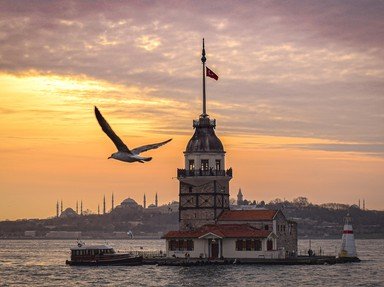Quiz Answer Key and Fun Facts
1. The historic centre of Istanbul is located partly on the Sea of Marmara and also on another body of water. Which of these is it?
2. In the course of its long history Istanbul has had various names. Which of these is NOT one of them?
3. Which of these dates is generally accepted as the year when the city became the capital of the Roman Empire?
4. The ancient and medieval areas of Istanbul are divided about equally between Europe and Asia.
5. What is the name of the residence that served as the Sultan's palace from the about 1470 till 1856?
6. One of the finest buildings in Istanbul is the Haghia Sofia, which was first a church, later a mosque and was turned into a museum in 1935. From when does the main part of the building - the Church of St. Sophia, date?
7. Opposite the Haghia Sofia is a large mosque. By what name is it generally known in English?
8. The Golden Horn separates the European from the Asian parts of Istanbul.
9. In what year did the Ottoman Turks take the city?
10. By a long-standing convention the Sultan's court and government was generally referred to in English as 'The Sublime Porte' from about 1700 (or earlier) till its demise in 1922. The expression is purely a formula and does not refer to any identifiable gate ('Porte').
Source: Author
bloomsby
This quiz was reviewed by FunTrivia editor
minch before going online.
Any errors found in FunTrivia content are routinely corrected through our feedback system.

